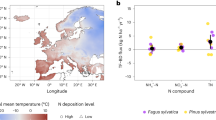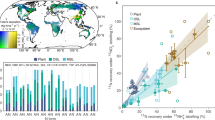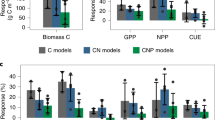Abstract
Conceptual1,2,3,4 and numerical5,6,7,8 models of nitrogen cycling in temperate forests assume that nitrogen is lost from these ecosystems predominantly by way of inorganic forms, such as nitrate and ammonium ions. Of these, nitrate is thought to be particularly mobile, being responsible for nitrogen loss to deep soil and stream waters. But human activities—such as fossil fuel combustion, fertilizer production and land-use change—have substantially altered the nitrogen cycle over large regions9, making it difficult to separate natural aspects of nitrogen cycling from those induced by human perturbations10. Here we report stream chemistry data from 100 unpolluted primary forests in temperate South America. Although the sites exhibit a broad range of environmental factors that influence ecosystem nutrient cycles11,12,13 (such as climate, parent material, time of ecosystem development, topography and biotic diversity), we observed a remarkably consistent pattern of nitrogen loss across all forests. In contrast to findings from forests in polluted regions, streamwater nitrate concentrations are exceedingly low, such that nitrate to ammonium ratios were less than unity, and dissolved organic nitrogen is responsible for the majority of nitrogen losses from these forests. We therefore suggest that organic nitrogen losses should be considered in models of forest nutrient cycling, which could help to explain observations of nutrient limitation in temperate forest ecosystems.
This is a preview of subscription content, access via your institution
Access options
Subscribe to this journal
Receive 51 print issues and online access
$199.00 per year
only $3.90 per issue
Buy this article
- Purchase on Springer Link
- Instant access to full article PDF
Prices may be subject to local taxes which are calculated during checkout



Similar content being viewed by others
References
Likens, G. E. & Bormann, F. H. Biogeochemistry of a Forested Ecosystem 2nd edn (Springer, New York, 1995).
Aber, J. et al. Nitrogen saturation in temperate forest ecosystems: Hypotheses revisited. BioScience 48, 921–34 (1998).
Tamm, C. O. Nitrogen in Terrestrial Ecosystems (Springer, Berlin, 1991).
Stoddard, J. L. in Environmental Chemistry of Lakes and Reservoirs (ed. Baker, L. A.) 223–284 (American Chemical Society, Washington DC, 1994).
Schimel, D. S., Braswell, B. H. & Parton, W. J. Equilibration of the terrestrial water, nitrogen, and carbon cycles. Proc. Natl Acad. Sci. USA 94, 8280–8283 (1997).
Rastetter, E. B. et al. Resource optimization and symbiotic nitrogen fixation. Ecosystems 4, 369–388 (2001).
McGuire, A. D. et al. Equilibrium responses of global net primary production and carbon storage to doubled atmospheric carbon dioxide: sensitivity to changes in vegetation nitrogen concentration. Glob. Biogeochem. Cycles 11, 173–189 (1997).
McKane, R. B. et al. Climatic effects on tundra carbon storage inferred from experimental data and a model. Ecology 78, 1170–1187 (1997).
Vitousek, P. M. et al. Human alteration of the global nitrogen cycle: Sources and consequences. Ecol. Appl. 7, 737–750 (1997).
Hedin, L. O., Armesto, J. J. & Johnson, A. H. Patterns of nutrient loss from unpolluted, old-growth temperate forests: Evaluation of biogeochemical theory. Ecology 76, 493–509 (1995).
Jenny, H. Factors of Soil Formation (McGraw-Hill, New York, 1941).
Gorham, E. Factors influencing supply of major ions to inland waters, with special reference to the atmosphere. Geol. Soc. Am. Bull. 72, 795–840 (1961).
Vitousek, P. M. & Reiners, W. A. Ecosystem succession and nutrient retention: a hypothesis. BioScience 25, 376–381 (1975).
Nadelhoffer, K. J. et al. Nitrogen deposition makes a minor contribution to carbon sequestration in temperate forests. Nature 398, 145–148 (1999).
Oren, R. et al. Soil fertility limits carbon sequestration by forest ecosystems in a CO2-enriched atmosphere. Nature 411, 469–472 (2001).
Holland, E. A., Dentener, F. J., Braswell, B. H. & Sulzman, J. M. Contemporary and pre-industrial global reactive nitrogen budgets. Biogeochemistry 46, 7–43 (1999).
Alaback, P. Comparative ecology of temperate rainforests of the Americas along analogous climatic gradients. Rev. Chil. Hist. Nat. 64, 399–412 (1991).
Almeyda, A. E. & Saez, S. F. Recopilación de Datos Climáticos de Chile y Mapas Sinópticos Respectivos (Ministerio de Agricultura, Santiago, Chile, 1958).
Paruelo, J. M., Beltran, A., Jobbagy, E. G., Sala, O. E. & Golluscio, R. A. The climate of Patagonia: General patterns and controls on biotic processes. Ecologia Austral 8, 85–101 (1998).
Villagran, C. (ed.) The Quaternary of the Lake District of Southern Chile. International Workshop “The Quaternary of Chile” (IGCP-281, Latin American Botanical Network, Santiago, Chile, 1993).
Veblen, T. T., Donoso, C., Kitzberger, T. & Rebertus, A. J. in The Ecology and Biogeography of Nothofagus Forests (eds Veblen, T. T., Hill, R. S. & Read, J.) 293–353 (Yale Univ. Press, New Haven, 1996).
Aguilar, R. & Arnold, R. W. Soil-landscape relationships of a climax forest in the Allegheny High Plateau, Pennsylvania. Soil Sci. Soc. Am. J. 49, 695–701 (1985).
Nodvin, S. C., Van Miegroet, H., Lindberg, S. E., Nicholas, N. S. & Johnson, D. W. Acidic deposition, ecosystem processes, and nitrogen saturation in a high elevation southern Appalachian watershed. Wat. Air Soil Pollut. 85, 1647–1652 (1995).
Goodale, C. L., Aber, J. D. & McDowell, W. H. The long-term effects of disturbance on organic and inorganic nitrogen export in the White Mountains, New Hampshire. Ecosystems 3, 433–450 (2001).
Campbell, J. L. et al. Dissolved organic nitrogen budgets for upland, forested ecosystems in New England. Biogeochemistry 49, 123–142 (2000).
McDowell, W. H., Currie, W. S., Aber, J. D. & Yano, Y. Effects of chronic nitrogen amendments on production of dissolved organic carbon and nitrogen in forest soils. Wat. Air Soil Pollut. 105, 175–182 (1998).
Perakis, S. S. & Hedin, L. O. Fluxes and fates of nitrogen in soil of an unpolluted old-growth temperate forest, southern Chile. Ecology 82, 2245–2260 (2001).
Sollins, P. et al. The internal element cycles of an old-growth Douglas-fir ecosystem in western Oregon. Ecol. Monogr. 50, 261–285 (1980).
Cleveland, C. C. et al. Global patterns of terrestrial biological nitrogen (N2) fixation in natural ecosystems. Glob. Biogeochem. Cycles 13, 623–645 (1999).
Weathers, K. C., Lovett, G. M., Likens, G. E. & Caraco, N. F. M. Cloudwater inputs of nitrogen to forest ecosystems in southern Chile: Forms, fluxes, and sources. Ecosystems 3, 590–595 (2000).
Vitousek, P. M., Hedin, L. O., Matson, P. A., Fownes, J. H. & Neff, J. in Successes, Limitations, and Frontiers in Ecosystem Science (eds Pace, M. L. & Groffman, P. M.) 432–451 (Springer, New York, 1998).
Acknowledgements
We thank S. Nodvin for sharing samples from CO and SF; M. Medina, B. Houlton, J. Armesto, C. Perez, G. Steinhart, J. O'Brien, G. Likens, J. Franklin, O. Sala, G. Lewis, T. Flum, J. Jamison, Corporación Nacional Forestal de Chile and Administración de Parque Nacionales de Argentina for site selection, field assistance and sample collection; M. Brown and K. Lohse for sample analysis; E. Boyer for cartography; and J. Compton, T. Fahey, R. Howarth, K. Lajtha, J. von Fischer, G. Lewis and P. Vitousek for comments on the manuscript. This work is a contribution to the Cordillera Piuchué Ecosystem Study and was supported by the Andrew W. Mellon Foundation, the NASA Earth Systems Science Fellowship Program and the US NSF.
Author information
Authors and Affiliations
Corresponding author
Supplementary information
Rights and permissions
About this article
Cite this article
Perakis, S., Hedin, L. Nitrogen loss from unpolluted South American forests mainly via dissolved organic compounds. Nature 415, 416–419 (2002). https://doi.org/10.1038/415416a
Received:
Accepted:
Issue Date:
DOI: https://doi.org/10.1038/415416a
This article is cited by
-
Overestimated nitrogen loss from denitrification for natural terrestrial ecosystems in CMIP6 Earth System Models
Nature Communications (2023)
-
Native Arbuscular Mycorrhizal Fungi Improved Araucaria araucana Growth over Commercial Inoculum Under Greenhouse and Field Conditions
Journal of Soil Science and Plant Nutrition (2023)
-
Substantial Organic and Particulate Nitrogen and Phosphorus Export from Geomorphologically Stable African Tropical Forest Landscapes
Ecosystems (2023)
-
Geological History and Forest Mycorrhizal Dominance Effects on Soil Fungal Diversity in Chilean Temperate Rainforests
Journal of Soil Science and Plant Nutrition (2023)
-
Determining patterns in the composition of dissolved organic matter in fresh waters according to land use and management
Biogeochemistry (2023)
Comments
By submitting a comment you agree to abide by our Terms and Community Guidelines. If you find something abusive or that does not comply with our terms or guidelines please flag it as inappropriate.



